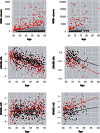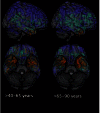White matter hyperintensities and imaging patterns of brain ageing in the general population
- PMID: 26912649
- PMCID: PMC5006227
- DOI: 10.1093/brain/aww008
White matter hyperintensities and imaging patterns of brain ageing in the general population
Abstract
White matter hyperintensities are associated with increased risk of dementia and cognitive decline. The current study investigates the relationship between white matter hyperintensities burden and patterns of brain atrophy associated with brain ageing and Alzheimer's disease in a large populatison-based sample (n = 2367) encompassing a wide age range (20-90 years), from the Study of Health in Pomerania. We quantified white matter hyperintensities using automated segmentation and summarized atrophy patterns using machine learning methods resulting in two indices: the SPARE-BA index (capturing age-related brain atrophy), and the SPARE-AD index (previously developed to capture patterns of atrophy found in patients with Alzheimer's disease). A characteristic pattern of age-related accumulation of white matter hyperintensities in both periventricular and deep white matter areas was found. Individuals with high white matter hyperintensities burden showed significantly (P < 0.0001) lower SPARE-BA and higher SPARE-AD values compared to those with low white matter hyperintensities burden, indicating that the former had more patterns of atrophy in brain regions typically affected by ageing and Alzheimer's disease dementia. To investigate a possibly causal role of white matter hyperintensities, structural equation modelling was used to quantify the effect of Framingham cardiovascular disease risk score and white matter hyperintensities burden on SPARE-BA, revealing a statistically significant (P < 0.0001) causal relationship between them. Structural equation modelling showed that the age effect on SPARE-BA was mediated by white matter hyperintensities and cardiovascular risk score each explaining 10.4% and 21.6% of the variance, respectively. The direct age effect explained 70.2% of the SPARE-BA variance. Only white matter hyperintensities significantly mediated the age effect on SPARE-AD explaining 32.8% of the variance. The direct age effect explained 66.0% of the SPARE-AD variance. Multivariable regression showed significant relationship between white matter hyperintensities volume and hypertension (P = 0.001), diabetes mellitus (P = 0.023), smoking (P = 0.002) and education level (P = 0.003). The only significant association with cognitive tests was with the immediate recall of the California verbal and learning memory test. No significant association was present with the APOE genotype. These results support the hypothesis that white matter hyperintensities contribute to patterns of brain atrophy found in beyond-normal brain ageing in the general population. White matter hyperintensities also contribute to brain atrophy patterns in regions related to Alzheimer's disease dementia, in agreement with their known additive role to the likelihood of dementia. Preventive strategies reducing the odds to develop cardiovascular disease and white matter hyperintensities could decrease the incidence or delay the onset of dementia.
Keywords: Alzheimer’s disease; brain ageing; cardiovascular disease; mild cognitive impairment; white matter hyperintensities.
© The Author (2016). Published by Oxford University Press on behalf of the Guarantors of Brain. All rights reserved. For Permissions, please email: journals.permissions@oup.com.
Figures







References
-
- Aribisala B, Valdés Hernández M, Royle N, Morris Z, Muñoz Maniega S, Bastin M , et al. . Brain atrophy associations with white matter lesions in the ageing brain: the Lothian Birth Cohort 1936 . Eur. Radiol 2013. ; 23 : 1084 – 92 . - PubMed
Publication types
MeSH terms
Grants and funding
LinkOut - more resources
Full Text Sources
Other Literature Sources
Medical
Miscellaneous

